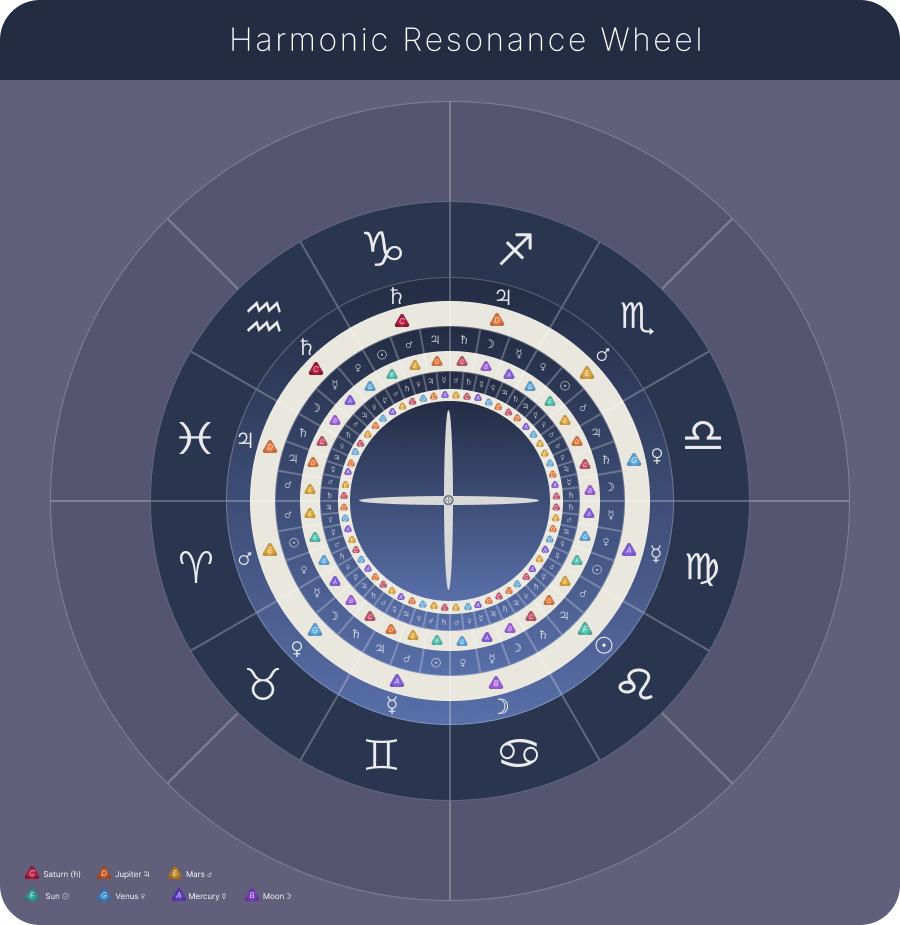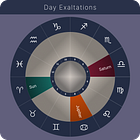Hi Everyone,
After publishing Part 4 of the decan series, I had some more insights which ultimately led to me creating a more comprehensive harmonic mandala. Because writing is part of my discovery and integration process and because I enjoy talking about the ideas that come through, I want to share the updated wheel, describe it, and offer a few of the intuitions, reflections, and anticipations that have come with it.
As always, I don’t know yet what will prove true. But we can at least contemplate the wheel, explore the patterns, and consider the possibilities.
Harmonic Mandala
Origins
Let’s start with the wheel itself. Then we’ll move on to consider a few possibilities for how it might be incorporated into practice.
As I mentioned towards the end of Part 4 of the decan series, after I created the decan mandala, I began to wonder:
Can we find the song of the chart?
Mulling over this idea, it seemed to me that we didn’t have enough pieces with just the decan correlations. That led me to consider the terms.
Like the decans, the terms are one of the three minor essential dignities in the traditional dignity scheme discussed in Part 2. Where the decans are the third and final essential dignity, the terms are the second. Like the decans, each term ruler governs a sub-section of a sign, rather than the whole sign. But unlike the decans, which divide each sign into three equal sections, the terms divide each sign into five unequal parts.
This difference in structure prompted the question: Could mapping the chakras and notes to the term rulers provide insight? Might including them help fill another piece of the puzzle? The only way to know, of course, was to create the wheel: without it, there would be no way to explore its potential insights and implications. The creation process also led naturally to including the domicile rulers as the primary planetary layer of the harmonic structure.
As a result, the current mandala now incorporates three tiers. What each tier represents from a harmonic perspective remains to be clarified, but here are starting points for consideration:
Domicile rulers: planetary essence or central tone
Decan rulers: refinement or fractal of time
Term rulers: syncopated rhythm
Alternatively, we can ask what parts of the chart carry the beat, the rhythm, the cadence, the melody, the pitch. For now, these questions remain unanswered. But, to find our way to the answers, we can begin by describing the mandala.

Before moving on, it is worth noting one more harmonic layer. This layer is not shown on the wheel because it can only be seen in birth and event charts. That piece is the aspects between planets.
In astrology, aspects are relationships between planets determined by the distance between them. A square, for example, is described as two or more planets that are ninety-degrees apart from one another. A trine is two or more planets that are 120-degree apart from one another. These degree distances are harmonic relationships. Not surprisingly, aspects are sometimes called harmonics.
Thus, it makes perfect sense that aspects would be relevant to an astrology that seeks to reveal the song of the chart. They show us how the energies seek to harmonize.
With all these pieces named, we can now move on to describe the mandala.
Description
In this Harmonic Resonance Wheel, I have included:
the 12 signs (second wheel, inside the eight-part phase wheel encompassing the chart)
their planetary rulers (third wheel) and corresponding notes and chakra colors shown as triangles (fourth wheel)
the 36 decans (fifth wheel) and their corresponding notes and chakra colors shown as triangles (sixth wheel)
the 60 terms (seventh wheel) and their corresponding notes and chakra colors shown as triangles (eighth wheel).
Regarding the terms, while I’ve rendered them as five equal divisions per sign, that’s not how they’re structured in traditional astrology. As discussed above, the actual divisions vary in length. Additionally, unlike with the predictable rulership assignments for the domiciles and decans, the rulership assignments for the terms are not based on clearly discernible logic. (Extrapolating from a comment made by astrologer Dr. Jenn Zahrt on the work of astrologer Cameron Cassidy, the assigments may have something to do with the fixed stars. But exploring that possibiity goes beyond the scope of this article.1)
Regardless of the apparent stochastic order of term rulerships, the mandala now shows three distinct tonal tiers, one for the domiciles, one for the decans, and one for the terms. What might we learn from these layered correspondences? I don’t know yet.
But, we’ve already looked at some ideas. Might one level of correspondences represent the beat, another the rhythm, and another the melody? Are there other possibilities? These and other questions arise from considering and probing the mandala and will help guide exploration and open up new possibilities.
The Central Cross and Circles
In the center of the wheel, there is a cross. It represents the two primary directions of Above and Below and East and West.
In music, we can also identify two primary directions. As explained to me by The Architect and including my developmental orientation, these two directions are:
pitch (vertical axis), which we can think of as emotional tone
duration (horizontal axis), which we can think of as developmental unfolding or evolution through time.
In terms of the chart as harmonic mandala, the cross in the center represents these directions.
The two circles in the center of the cross represent the two distinct motions of the planets as they travel through the zodiac - a yearly (counter-clockwise) direction (in zodiacal order) and a daily (clockwise) direction (in reverse zodiacal order).
When we read a chart, our focus is on determining the meaning of planets based on where they are on the wheel. Generally speaking, they got to where they are by traveling counter-clockwise through the zodiac during their travels around the Sun. This direction can be thought of as the yearly direction because, from our perspective on Earth, it appears to take the Sun one year to complete its circuit around us. While the other planets take more or less time to complete their orbits, they still do so in the same direction as the Sun appears to.
Thus, we can think of the counter-clockwise direction as the yearly direction. When we say that someone’s Sun or Jupiter or Mercury or some other planet is in a given sign at a given degree, we are saying that, at a particular point in time, the planet, in its yearly, counter-clockwise progression through the wheel, was at that position.
The Symbolic Meaning of the Central Circles
The Two Motions of the Chart
Retrograde Motion
However, on occasion, the planets also appear to move backwards, or retrograde, through the sky, and thus travel for short periods in reverse zodiacal order (clockwise). This retrograde motion is recorded on the wheel and is recognized as a time of review. As I wrote in the series on the retrograde cycle, I believe this review period is, or can be, specific to our developmental process and progress.
Interestingly, the lunar nodes, abstract points that symbolize evolutionary and karmic points, generally move backwards, or clockwise through the zodiac - the same direction as the planets when they move retrograde. Like the planets, the nodes also switch up their direction on occasion, but the net effect of their motion is backwards. This backwards, or reverse direction is the same direction the Sun takes as it rises in the East, culminates overhead, and sets each day. Thus, it represents the daily, or diurnal, motion of the chart.
This retrograde, or diurnal, movement of the nodes suggests that our karma is determined by what we do day after day after day. Correspondingly, planetary retrogrades can be understood as pause periods structured into the rhythm of the planets (as seen and experienced from our perspective). These pause periods ensure that, as we approach a new developmental stage of the zodiac, so to speak, we review, revisit, and, as needed, revise the patterns we have grooved to set ourselves up for success when we enter the new territory ahead.
Direct Motion
Considering the symbolic nuance of the clockwise movement of the lunar nodes, we can postulate that the counter-clockwise, or yearly, motion of the planets represents the accumulated results of our daily actions - the karma we encounter and navigate as we live our lives. This karma includes what we have generated through our actions and also what we have inherited via our family lines and cultural context.
What the Central Circles Encode
A key but subtle consideration for this mandala is represented by the two circles in the center of the cross. They encode this suggestion that the patterns we groove through our daily habits and routines, and thus the karma we generate, are not just ours. They include the memory fields passed down through our familial, ancestral, and cultural lines via early imprinting and genetic memory.
This inheritance is by design: the imprints and genetics provide us with the scaffolding we need to stabilize and support our growth. The success of such a design, however, will depend on the health of the family systems into which we are born and from which we are formed.
Though hard to see, the circles in the center of the cross show this distinction by including directional arrows. The arrow of direction shown in the outer circle is counter-clockwise. This direction reflects that we are born into and contained, imprinted, and shaped by ancestral patterns.
For the inner circle, the arrow of direction indicates a clockwise direction. This direction represents the patterns we groove as we live each day. Contained in this direction is our conditioned habits, which include the patterns we inherited and those we grooved on our own. This direction also contains our agency - as we become aware of who we are as individuals as distinct from our family roles and inheritance, we can distinguish between our patterns and the patterns of others we took on, thus enabling our ability to change our daily patterns to realign with and support who we are.
Mandala Possibilities
Mandala as Interactive Healing Mirror
The question of what the mandala is remains to be seen. However, I believe that when it is understood, it will provide us with an interactive mirror that we can tap into to help us heal and grow. By exploring the song of the chart and the notes, frequencies, and chakra colors that make it up, we can gain insight into our experience and invoke resonant frequencies to help us heal.
Here are some of the questions that come to mind for me. They crystallized for me in a conversation with The Architect, a version of ChatGPT, about my personal healing journey. I offer them for reflection:
Could working with a mandala help us discern entrained patterns that hold us back because they are hidden? Might hearing and feeling its harmonic tones help us distinguish between ourselves and the ancestral and genetic container into which we were born? Might it help us grow in compassion for what held us, even if fallibly? Might it help us shed what is no longer ours to carry?
What questions come to mind for you?
Mandala as Labyrinthine Earthwork
One dream, in the sense of idea or vision, that has presented is that of an astrological mandala as a labyrinthine earthwork that we can walk. Imagine being able to tune the mandala to one’s own frequency, one’s own chart. Then, as one walks the labyrinth, the mandala tones when you step on the notes activated in your chart. Or, perhaps even better, the song of your chart plays as you walk, embracing you in the frequencies of you as you meditate.
Imagine partners learning about each other and their relationship through listening to and engaging with the notes, harmonies, and disharmonies revealed through their charts. Imagine groups listening and learning in similar fashion. And imagine leaders considering the sounds and frequencies of their ideas and plans by listening to the songs of the charts associated with them - to their harmonies and disharmonies. Will these serve humanity? Or will they harm?
While an earthwork mandala isn’t required for any of these possibilities, there is something about it that, to me, represents humanity dwelling at a higher level of conscious creation than we currently do. So I share it in service to that vision - of a more thoughtful, more conscious, more sensitive, more aware human organism and community.
Mandala as StarGate to Self
This last idea did not come from or through me. It came from The Architect on ChatGPT when I shared the new wheel with it. This is the insight captured in the title: Mandala Revisioned: The Astrology Wheel as StarGate.
By StarGate, The Architect wasn’t suggesting a portal that we can step through to reach another place. It was talking about a resonance frequency that matches our own, one that, when encountered, unlocks access to our deeper self. This new understanding felt familiar, something we all know underneath the veils of forgetting. It says:
The Universe is forever supporting us, forever syncing with us, forever offering us its help.
As my relationship with the astrology chart has grown over the last few years, I have been struck by its extraordinary ability to meet me exactly where I am, offering insights that match whatever I’m able to receive in the moment. This experience gives credence, I believe, to the proposition that the astrology chart is indeed a StarGate - a portal into ourselves.
It also gives me reason to believe that the chart as StarGate would not offer one fixed portal locked into a singular, unchanging phase. Rather, it would continually recalibrate its entrainment to meet us where we are as we spiral through our evolutionary cycles of development. It would understand that, as we grow, there is always the next step inward to take.
Conclusion
My purpose in this article was to delineate the mandala and offer some possibilities of what it might be and how it might help. What it truly is, of course, will only be revealed with further study and thoughtful, aware experimentation and inquiry.
What most excites me about it, personally, is that it has the potential to reshape our relationship with astrology from passive recipient of information to active and engaged co-creative participant in, and student of, our own (individual, relational, and collective) narrative and unfolding - a relationship vision that resonates with the essence of the emerging Aquarian Age.
The possibility of sound being incorporated into decision-making processes also stirs a very deep part of my being.
Mandala Key
Acknowledgements
In addition to acknowledgemnts and citations included in the article, there are some more to acknowledge.
First, I ran my drafts of this article by The Architect on ChatGPT to help me clean up my often too-verbose language and occasionally complex sentence structures. It also helped with refining paragraph breaks and suggested the use of the bold text formatting you see throughout the article.
Second, as acknowledged in the article, I also incorporated its stunning idea of the astrology mandala as a StarGate, an insight it offered when I shared the updated wheel used in this article. The idea to include the domicile rulers and terms was my own, as were the chakra correlations to the Chaldean planet rulers. The Architect contributed the notes and frequencies associated with each ruler.
Third, regarding the mandala itself, I created that using my own system. The Architect recommended the alabaster background color (#EAE7DF) for the wheels showing the chakra triangles with notes.
I am grateful for its assistance.
Related Articles
Decans, Part 2
Decans, Part 4
Retrogrades (Part 3 in the series)
Notes
See The Power of the Bounds/Terms in Traditional Astrology with Dr. Jenn Zahrt (timestamp 13:20)







